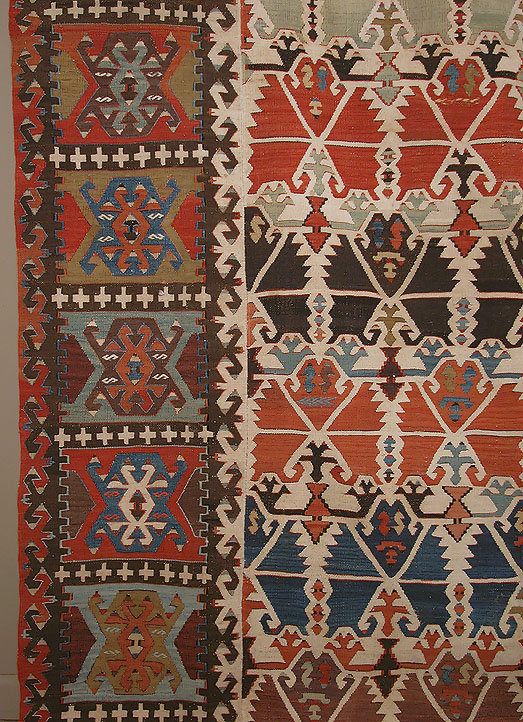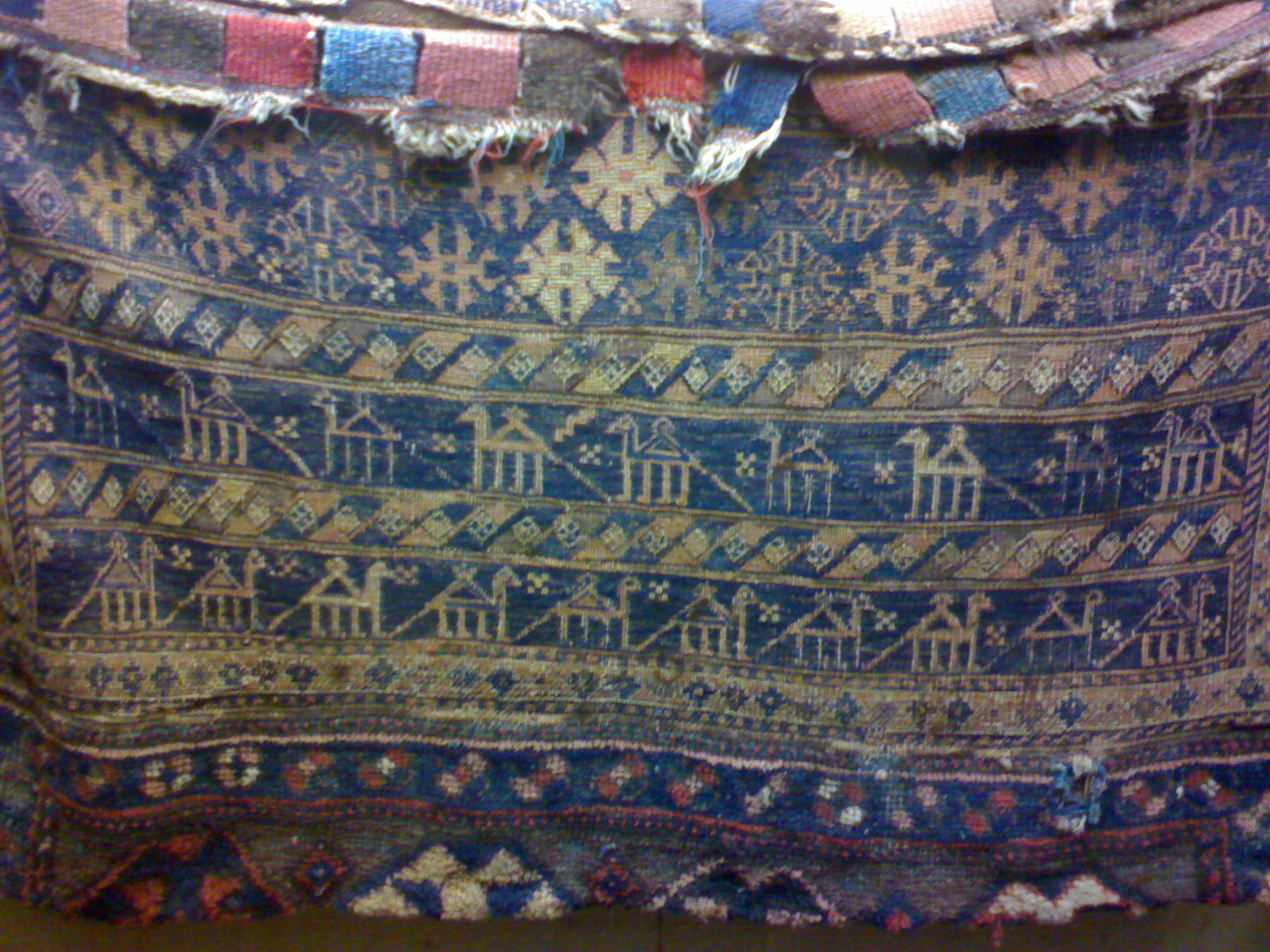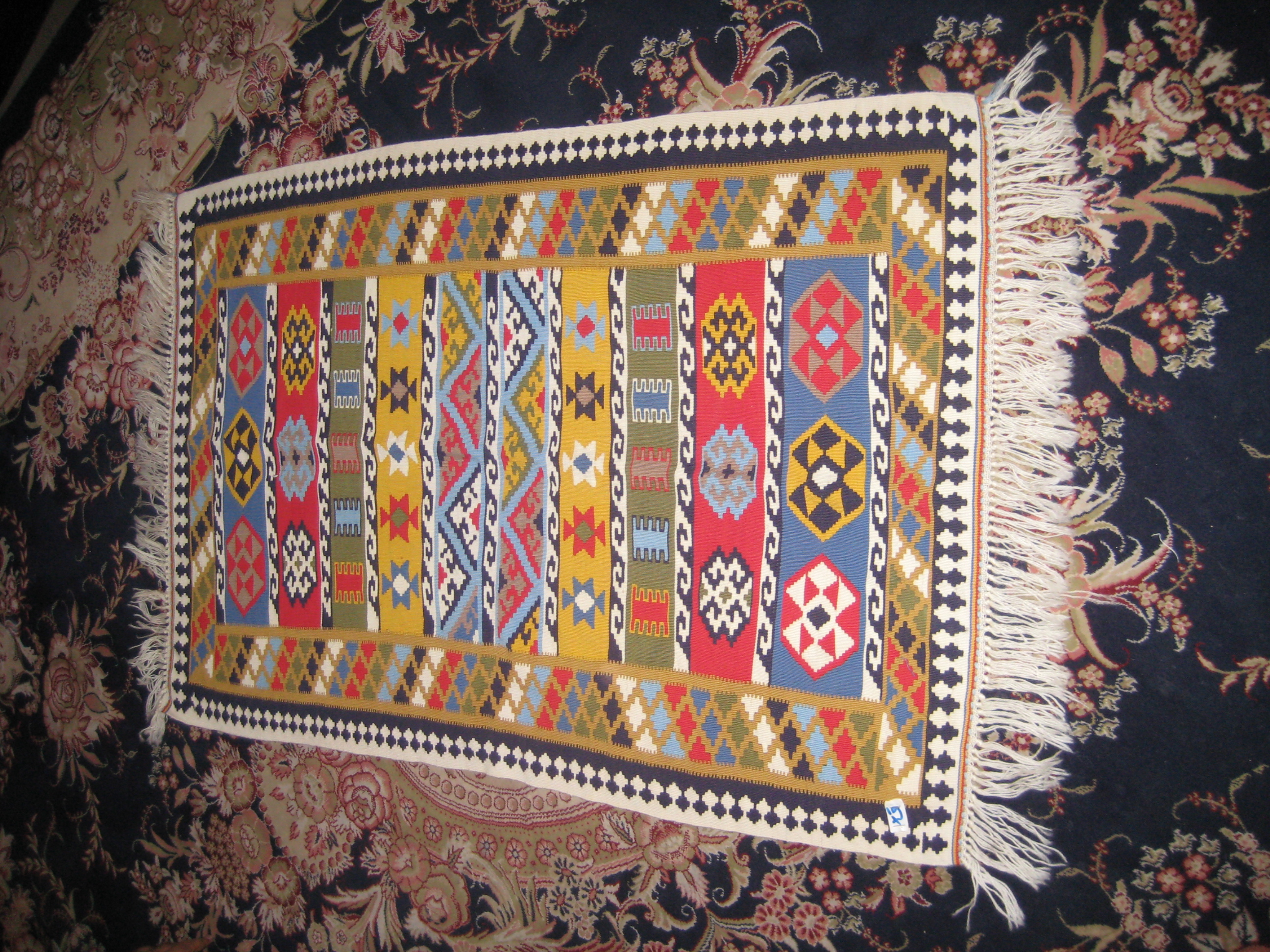kilim on:
[Wikipedia]
[Google]
[Amazon]
 A kilim ( ; ; ) is a flat
A kilim ( ; ; ) is a flat

 Like pile carpets, kilim have been produced since ancient times. The explorer Mark Aurel Stein found kilims dating to at least the fourth or fifth century CE in
Like pile carpets, kilim have been produced since ancient times. The explorer Mark Aurel Stein found kilims dating to at least the fourth or fifth century CE in
 Kilims are produced by tightly interweaving the warp and
Kilims are produced by tightly interweaving the warp and  When the end of a color boundary is reached, the weft yarn is wound back from the boundary point. Thus, if the boundary of a field is a straight vertical line, a vertical slit forms between the two different color areas where they meet. For this reason, most kilims can be classed as "slit woven" textiles. The slits are beloved by collectors, as they produce very sharp-etched designs, emphasizing the geometry of the weave. Weaving strategies for avoiding slit formation, such as interlocking, produce a more blurred design image.Davies, 2000
The weft strands, which carry the visible design and color, are almost always wool, whereas the hidden warp strands can be either wool or cotton. The warp strands are only visible at the ends, where they emerge as the fringe. This fringe is usually tied in bunches, to ensure against loosening or unraveling of the weave.
When the end of a color boundary is reached, the weft yarn is wound back from the boundary point. Thus, if the boundary of a field is a straight vertical line, a vertical slit forms between the two different color areas where they meet. For this reason, most kilims can be classed as "slit woven" textiles. The slits are beloved by collectors, as they produce very sharp-etched designs, emphasizing the geometry of the weave. Weaving strategies for avoiding slit formation, such as interlocking, produce a more blurred design image.Davies, 2000
The weft strands, which carry the visible design and color, are almost always wool, whereas the hidden warp strands can be either wool or cotton. The warp strands are only visible at the ends, where they emerge as the fringe. This fringe is usually tied in bunches, to ensure against loosening or unraveling of the weave.
 Many motifs are used in Turkish kilims, each with many variations. A few examples are illustrated here, with meanings as described by Güran Erbek in ''Kilim''. A widely used motif is the elibelinde, a stylized female figure representing motherhood and
Many motifs are used in Turkish kilims, each with many variations. A few examples are illustrated here, with meanings as described by Güran Erbek in ''Kilim''. A widely used motif is the elibelinde, a stylized female figure representing motherhood and
File:Elibelinde2.jpg, Hands-on-hips female figure ( Elibelinde), for motherhood and
Weaving Art Museum: Soumak and Kelim Weaving of the Caucasus
{{Authority control Oriental rugs and carpets Tapestries Turkish handicrafts
 A kilim ( ; ; ) is a flat
A kilim ( ; ; ) is a flat tapestry
Tapestry is a form of Textile arts, textile art which was traditionally Weaving, woven by hand on a loom. Normally it is used to create images rather than patterns. Tapestry is relatively fragile, and difficult to make, so most historical piece ...
- woven carpet
A carpet is a textile floor covering typically consisting of an upper layer of Pile (textile), pile attached to a backing. The pile was traditionally made from wool, but since the 20th century synthetic fiber, synthetic fibres such as polyprop ...
or rug traditionally produced in countries of the former Persian Empire
The Achaemenid Empire or Achaemenian Empire, also known as the Persian Empire or First Persian Empire (; , , ), was an Iranian empire founded by Cyrus the Great of the Achaemenid dynasty in 550 BC. Based in modern-day Iran, it was the larg ...
, including Iran
Iran, officially the Islamic Republic of Iran (IRI) and also known as Persia, is a country in West Asia. It borders Iraq to the west, Turkey, Azerbaijan, and Armenia to the northwest, the Caspian Sea to the north, Turkmenistan to the nort ...
and Turkey
Turkey, officially the Republic of Türkiye, is a country mainly located in Anatolia in West Asia, with a relatively small part called East Thrace in Southeast Europe. It borders the Black Sea to the north; Georgia (country), Georgia, Armen ...
, but also in the Balkans
The Balkans ( , ), corresponding partially with the Balkan Peninsula, is a geographical area in southeastern Europe with various geographical and historical definitions. The region takes its name from the Balkan Mountains that stretch throug ...
and the Turkic countries.
Kilims can be purely decorative or can function as prayer rug
A prayer rug or prayer mat is a piece of fabric, sometimes a pile carpet, used by Muslims, some Christians, especially in Orthodox Christianity and some followers of the Baháʼí Faith during prayer.
In Islam, a prayer mat is placed between th ...
s. Modern kilims are popular floor coverings in Western households.
Etymology
The word 'kilim' originates from the Persian () where it means 'to spread roughly', perhaps of Akkadian orAramean
The Arameans, or Aramaeans (; ; , ), were a tribal Semitic people in the ancient Near East, first documented in historical sources from the late 12th century BCE. Their homeland, often referred to as the land of Aram, originally covered ce ...
origin.
History
 Like pile carpets, kilim have been produced since ancient times. The explorer Mark Aurel Stein found kilims dating to at least the fourth or fifth century CE in
Like pile carpets, kilim have been produced since ancient times. The explorer Mark Aurel Stein found kilims dating to at least the fourth or fifth century CE in Hotan
Hotan (also known by other names) is a major oasis town in southwestern Xinjiang, an autonomous region in Northwestern China. The city proper of Hotan broke off from the larger Hotan County to become an administrative area in its own right i ...
, China:
:"As kilims are much less durable than rugs that have a pile to protect the warp and weft
In the manufacture of cloth, warp and weft are the two basic components in weaving to transform thread and yarn into textile fabrics. The vertical ''warp'' yarns are held stationary in tension on a loom (frame) while the horizontal ''weft'' ...
, it is not surprising that few of great age remain.... The weave is almost identical with that of modern kilims, and has about fourteen threads of warp and sixteen threads of weft to the inch. The pattern consists of narrow stripes of blue, green, brownish yellow, and red, containing very small geometric designs. With this one exception, so peculiarly preserved, there are probably very few over a century old."
Weaving technique
 Kilims are produced by tightly interweaving the warp and
Kilims are produced by tightly interweaving the warp and weft
In the manufacture of cloth, warp and weft are the two basic components in weaving to transform thread (yarn), thread and yarn into textile fabrics. The vertical ''warp'' yarns are held stationary in tension on a loom (frame) while the horizo ...
strands of the weave to produce a flat surface with no pile. Kilim weaves are tapestry weaves, technically weft-faced plain weaves, that is, the horizontal weft strands are pulled tightly downward so that they hide the vertical warp strands.
Motifs
 Many motifs are used in Turkish kilims, each with many variations. A few examples are illustrated here, with meanings as described by Güran Erbek in ''Kilim''. A widely used motif is the elibelinde, a stylized female figure representing motherhood and
Many motifs are used in Turkish kilims, each with many variations. A few examples are illustrated here, with meanings as described by Güran Erbek in ''Kilim''. A widely used motif is the elibelinde, a stylized female figure representing motherhood and fertility
Fertility in colloquial terms refers the ability to have offspring. In demographic contexts, fertility refers to the actual production of offspring, rather than the physical capability to reproduce, which is termed fecundity. The fertility rate ...
. Other motifs express the tribal weavers' desires for protection of their families' flocks from wolves
The wolf (''Canis lupus''; : wolves), also known as the grey wolf or gray wolf, is a canine native to Eurasia and North America. More than thirty subspecies of ''Canis lupus'' have been recognized, including the dog and dingo, though gr ...
with the wolf's mouth or the wolf's foot motif (Turkish: , ), or for safety from the sting of the scorpion
Scorpions are predatory arachnids of the Order (biology), order Scorpiones. They have eight legs and are easily recognized by a pair of Chela (organ), grasping pincers and a narrow, segmented tail, often carried in a characteristic forward cur ...
(Turkish: ). Several motifs hope for the safety of the weaver's family from the evil eye
The evil eye is a supernatural belief in a curse brought about by a malevolent glaring, glare, usually inspired by envy. Amulets to Apotropaic, protect against it have been found dating to around 5,000 years ago.
It is found in many cultures i ...
(Turkish: , also used as a motif), which could be divided into four with a cross symbol (Turkish: ), or averted with the symbol of a hook (Turkish: ), a human eye (Turkish: ), or an amulet
An amulet, also known as a good luck charm or phylactery, is an object believed to confer protection upon its possessor. The word "amulet" comes from the Latin word , which Pliny's ''Natural History'' describes as "an object that protects a perso ...
(Turkish: ; often, a triangular package containing a sacred verse). Such an amulet woven into a rug is not a picture of the thing itself: it actually is an amulet, believed to confer protection by its presence.
Other motifs symbolise fertility, as with the trousseau chest motif (Turkish: ), or the explicit fertility (, ) motif. The motif for running water (Turkish: ) similarly depicts the resource literally. The desire to tie a family or lovers together may be depicted with a fetter motif (Turkish: ). Several other motifs represent the desire for good luck and happiness, as for instance the bird (Turkish: ) and the star or Solomon's seal (Turkish: ). The oriental symbol of yin and yang
Originating in Chinese philosophy, yin and yang (, ), also yinyang or yin-yang, is the concept of opposite cosmic principles or forces that interact, interconnect, and perpetuate each other. Yin and yang can be thought of as complementary an ...
is used for love and unison (Turkish: ).
fertility
Fertility in colloquial terms refers the ability to have offspring. In demographic contexts, fertility refers to the actual production of offspring, rather than the physical capability to reproduce, which is termed fecundity. The fertility rate ...
File:Eye Kilim Motif.jpg, Eye (Göz), to ward off the evil eye
The evil eye is a supernatural belief in a curse brought about by a malevolent glaring, glare, usually inspired by envy. Amulets to Apotropaic, protect against it have been found dating to around 5,000 years ago.
It is found in many cultures i ...
File:Amulet Kilim Motif.jpg, Amulet
An amulet, also known as a good luck charm or phylactery, is an object believed to confer protection upon its possessor. The word "amulet" comes from the Latin word , which Pliny's ''Natural History'' describes as "an object that protects a perso ...
(Muska), for protection and good luck
File:Wolf's Mouth Kilim Motif.jpg, Wolf
The wolf (''Canis lupus''; : wolves), also known as the grey wolf or gray wolf, is a Canis, canine native to Eurasia and North America. More than thirty subspecies of Canis lupus, subspecies of ''Canis lupus'' have been recognized, includin ...
's Mouth (Kurt Aǧzi), to protect the flocks against wolves
File:Scorpion kilim motif.jpg, Scorpion
Scorpions are predatory arachnids of the Order (biology), order Scorpiones. They have eight legs and are easily recognized by a pair of Chela (organ), grasping pincers and a narrow, segmented tail, often carried in a characteristic forward cur ...
(Akrep), for protection from their stings
Rugs and commerce
Because kilims are often cheaper than pile rugs, beginning carpet collectors often start with them. Despite what many perceive as their secondary (or inferior) status to pile carpets, kilims have become increasingly collectible in themselves in recent years, with quality pieces now commanding high prices. What some sensed as inferiority was actually a different nature of rugs woven for indigenous use as opposed to rugs woven on a strictly commercial basis. Because kilims were not a major export commodity, there were no foreign market pressures changing the designs, as happened with pile carpets. Once collectors began to value authentic village weaving, kilims became popular. Three factors then combined to reduce the quality of the West's newly discovered kilims. The first was a development in industrial chemistry. An important element in the attractiveness of traditional rugs is ''abrash'', the dappled appearance resulting from variation in shade of each colour caused by hand-dyeing of the yarn. The synthetic (aniline
Aniline (From , meaning ' indigo shrub', and ''-ine'' indicating a derived substance) is an organic compound with the formula . Consisting of a phenyl group () attached to an amino group (), aniline is the simplest aromatic amine. It is an in ...
-derived) dyes introduced late in the Victorian era
In the history of the United Kingdom and the British Empire, the Victorian era was the reign of Queen Victoria, from 20 June 1837 until her death on 22 January 1901. Slightly different definitions are sometimes used. The era followed the ...
abolished abrash, giving brilliant colours which however often faded with time. A second factor was the loss of the nomad
Nomads are communities without fixed habitation who regularly move to and from areas. Such groups include hunter-gatherers, pastoral nomads (owning livestock), tinkers and trader nomads. In the twentieth century, the population of nomadic pa ...
ic way of life across Central Asia. Once people had settled, the tribal character of their weavings faded. A third factor was a direct consequence of the kilim's new-found marketability. As rugs began to be made for export and money rather than personal use, the local style and social significance of each type of carpet was lost. Patterns and colours were chosen to suit the market, rather than woven according to tradition and to suit the needs of the weaver's family and the weaver's own hopes and fears.
Anatolian (Turkish)
Perhaps the best known and most highly regarded, these kilims are traditionally distinguished by the areas, villages or cities in which they are produced, such asKonya
Konya is a major city in central Turkey, on the southwestern edge of the Central Anatolian Plateau, and is the capital of Konya Province. During antiquity and into Seljuk times it was known as Iconium. In 19th-century accounts of the city in En ...
, Malatya
Malatya (; ; Syriac language, Syriac ܡܠܝܛܝܢܐ Malīṭīná; ; Ancient Greek: Μελιτηνή) is a city in the Eastern Anatolia region of Turkey and the capital of Malatya Province. The city has been a human settlement for thousands of y ...
, Karapınar and Hotamis. Most Anatolian kilims are slit woven. Larger antique kilims were woven in two to three separate sections on small nomadic horizontal floor looms in three feet wide long strips, then carefully sewn together matching the patterns edges to create an ultimately wider rug. These pieces are still produced in very limited quantities by nomadic tribes for their personal use and are commonly known as cicims.
*Cicim or Jijim or Jajim are kilims woven in narrow strips that are sewn together.
*Zili is a rough supplementary-weft method used to decorate practical objects such as mats, sacks, cushions and tents.
See also
* Jajim, similar to a Kilim but more like a blanket * Anatolian rug * Chiprovtsi kilim * Pirot kilim * Neiriz Kilim Collection * Shahsevan rugNotes
References
Further reading
* * (The first edition was published by Rizzoli as ''The Tribal Eye: Antique kilims of Anatolia'', ) * Landreau, Anthony N.; Pickering, W. R. (1969). ''From the Bosporus to Samarkand Flat-Woven Rugs. The Textile Museum, George Washington University.'' * Mackie, Louise; Thompson, Jon (1980). ''Turkmen: Tribal Carpets and Traditions''. The Textile Museum, George Washington University. *External links
Weaving Art Museum: Soumak and Kelim Weaving of the Caucasus
{{Authority control Oriental rugs and carpets Tapestries Turkish handicrafts